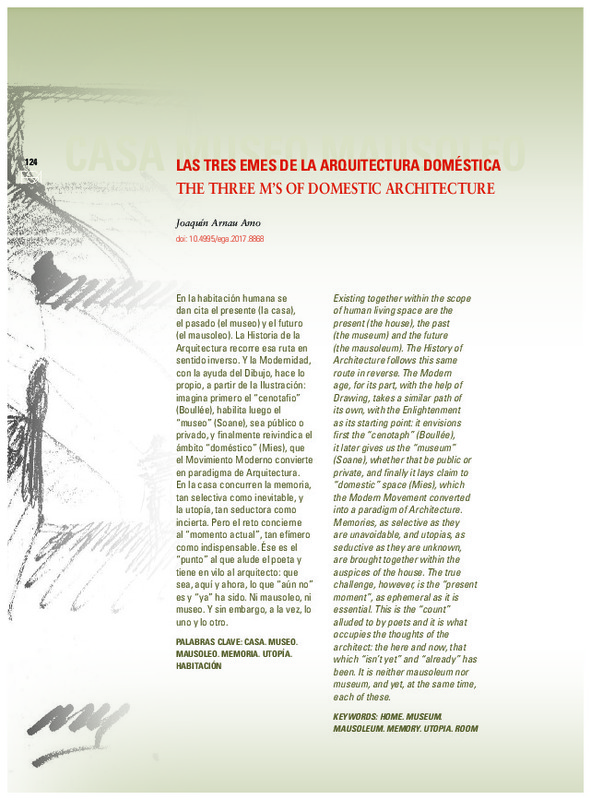JavaScript is disabled for your browser. Some features of this site may not work without it.
Buscar en RiuNet
Listar
Mi cuenta
Estadísticas
Ayuda RiuNet
Admin. UPV
Las tres emes de la arquitectura doméstica
Mostrar el registro sencillo del ítem
Ficheros en el ítem
| dc.contributor.author | Arnau Amo, Joaquín
|
es_ES |
| dc.date.accessioned | 2017-11-23T13:13:59Z | |
| dc.date.available | 2017-11-23T13:13:59Z | |
| dc.date.issued | 2017-11-21 | |
| dc.identifier.issn | 1133-6137 | |
| dc.identifier.uri | http://hdl.handle.net/10251/91407 | |
| dc.description.abstract | [EN] Existing together within the scope of human living space are the present (the house), the past (the museum) and the future (the mausoleum). The History of Architecture follows this same route in reverse. The Modern age, for its part, with the help of Drawing, takes a similar path of its own, with the Enlightenment as its starting point: it envisions first the “cenotaph” (Boullée), it later gives us the “museum” (Soane), whether that be public or private, and finally it lays claim to “domestic” space (Mies), which the Modern Movement converted into a paradigm of Architecture. Memories, as selective as they are unavoidable, and utopias, as seductive as they are unknown, are brought together within the auspices of the house. The true challenge, however, is the “present moment”, as ephemeral as it is essential. This is the “count” alluded to by poets and it is what occupies the thoughts of the architect: the here and now, that which “isn’t yet” and “already” has been. It is neither mausoleum nor museum, and yet, at the same time, each of these. | es_ES |
| dc.description.abstract | [ES] En la habitación humana se dan cita el presente (la casa), el pasado (el museo) y el futuro (el mausoleo). La Historia de la Arquitectura recorre esa ruta en sentido inverso. Y la Modernidad, con la ayuda del Dibujo, hace lo propio, a partir de la Ilustración: imagina primero el “cenotafio” (Boullée), habilita luego el “museo” (Soane), sea público o privado, y finalmente reivindica el ámbito “doméstico” (Mies), que el Movimiento Moderno convierte en paradigma de Arquitectura. En la casa concurren la memoria, tan selectiva como inevitable, y la utopía, tan seductora como incierta. Pero el reto concierne al “momento actual”, tan efímero como indispensable. Ése es el “punto” al que alude el poeta y tiene en vilo al arquitecto: que sea, aquí y ahora, lo que “aún no” es y “ya” ha sido. Ni mausoleo, ni museo. Y sin embargo, a la vez, lo uno y lo otro. | es_ES |
| dc.language | Español | es_ES |
| dc.language | Inglés | es_ES |
| dc.publisher | Universitat Politècnica de València | |
| dc.relation.ispartof | EGA. Revista de Expresión Gráfica Arquitectónica | |
| dc.rights | Reserva de todos los derechos | es_ES |
| dc.subject | Casa | es_ES |
| dc.subject | Museo | es_ES |
| dc.subject | Mausoleo | es_ES |
| dc.subject | Memoria | es_ES |
| dc.subject | Utopía | es_ES |
| dc.subject | Habitación | es_ES |
| dc.subject | Home | es_ES |
| dc.subject | Museum | es_ES |
| dc.subject | Mausoleum | es_ES |
| dc.subject | Memory | es_ES |
| dc.subject | Utopia | es_ES |
| dc.subject | Room | es_ES |
| dc.title | Las tres emes de la arquitectura doméstica | es_ES |
| dc.title.alternative | The three m's of domestic architecture | es_ES |
| dc.type | Artículo | es_ES |
| dc.date.updated | 2017-11-23T08:25:35Z | |
| dc.identifier.doi | 10.4995/ega.2017.8868 | |
| dc.rights.accessRights | Abierto | es_ES |
| dc.contributor.affiliation | Universitat Politècnica de València. Departamento de Composición Arquitectónica - Departament de Composició Arquitectònica | es_ES |
| dc.description.bibliographicCitation | Arnau Amo, J. (2017). Las tres emes de la arquitectura doméstica. EGA. Revista de Expresión Gráfica Arquitectónica. 22(31):124-131. https://doi.org/10.4995/ega.2017.8868 | es_ES |
| dc.description.accrualMethod | SWORD | es_ES |
| dc.relation.publisherversion | https://doi.org/10.4995/ega.2017.8868 | es_ES |
| dc.description.upvformatpinicio | 124 | es_ES |
| dc.description.upvformatpfin | 131 | es_ES |
| dc.type.version | info:eu-repo/semantics/publishedVersion | es_ES |
| dc.description.volume | 22 | |
| dc.description.issue | 31 | |
| dc.identifier.eissn | 2254-6103 | |
| dc.description.references | AAVV, 1996. Nuevos modos de habitar. New ways of housing. Valencia: COACV. | es_ES |
| dc.description.references | Arnau, J., 2014. El espacio, la luz y lo santo. Albacete: COACM. | es_ES |
| dc.description.references | Banham, R., 1965. Teoría y dise-o arquitectónico en la era de la máquina. Buenos Aires: Nueva Visión. | es_ES |
| dc.description.references | Boullée, É. L., 1985: Arquitectura. Ensayo sobre el arte. Barcelona: Gustavo Gili. | es_ES |
| dc.description.references | Choisy, A., 1971. Vitruve. Paris: F. de Nobele. | es_ES |
| dc.description.references | Hegel, G. F., 1947. Sistema de las artes particulares. Madrid: Espasa-Calpe. | es_ES |
| dc.description.references | Paladio, A., 1570. I Quattro Libri dell'Architettura. Venezia: Dominico de Franceschi. | es_ES |
| dc.description.references | Rykwert, J., 1974. La casa de Adán en el paraíso. Barcelona: Gustavo Gili. | es_ES |








